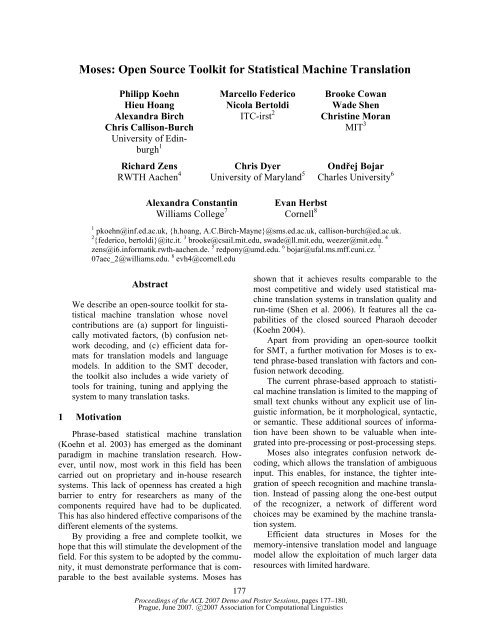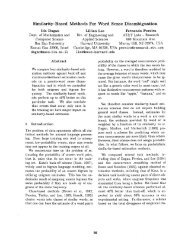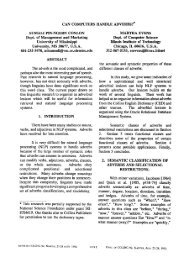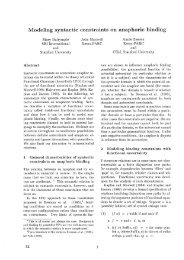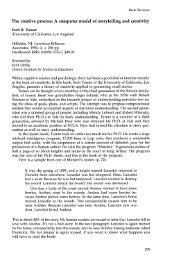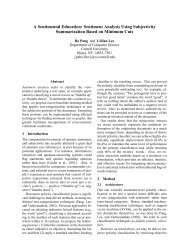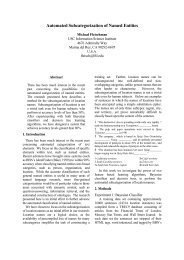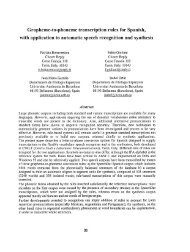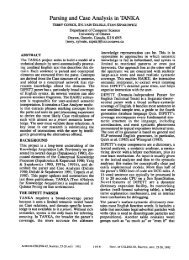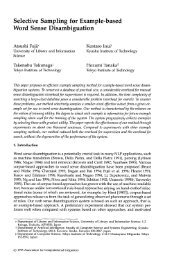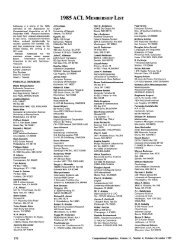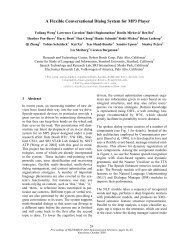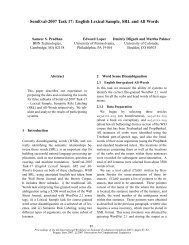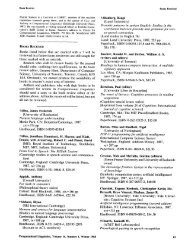Moses: Open Source Toolkit for Statistical Machine Translation
Moses: Open Source Toolkit for Statistical Machine Translation
Moses: Open Source Toolkit for Statistical Machine Translation
Create successful ePaper yourself
Turn your PDF publications into a flip-book with our unique Google optimized e-Paper software.
<strong>Moses</strong>: <strong>Open</strong> <strong>Source</strong> <strong>Toolkit</strong> <strong>for</strong> <strong>Statistical</strong> <strong>Machine</strong> <strong>Translation</strong><br />
Philipp Koehn<br />
Hieu Hoang<br />
Alexandra Birch<br />
Chris Callison-Burch<br />
University of Edinburgh<br />
1<br />
Richard Zens<br />
RWTH Aachen 4<br />
Alexandra Constantin<br />
Williams College 7<br />
Marcello Federico<br />
Nicola Bertoldi<br />
ITC-irst 2<br />
Chris Dyer<br />
University of Maryland 5<br />
Evan Herbst<br />
Cornell 8<br />
177<br />
Proceedings of the ACL 2007 Demo and Poster Sessions, pages 177–180,<br />
Prague, June 2007. c○2007 Association <strong>for</strong> Computational Linguistics<br />
Brooke Cowan<br />
Wade Shen<br />
Christine Moran<br />
MIT 3<br />
Ondřej Bojar<br />
Charles University 6<br />
1<br />
pkoehn@inf.ed.ac.uk, {h.hoang, A.C.Birch-Mayne}@sms.ed.ac.uk, callison-burch@ed.ac.uk.<br />
2 3 4<br />
{federico, bertoldi}@itc.it. brooke@csail.mit.edu, swade@ll.mit.edu, weezer@mit.edu.<br />
zens@i6.in<strong>for</strong>matik.rwth-aachen.de. 5 redpony@umd.edu. 6 bojar@ufal.ms.mff.cuni.cz. 7<br />
07aec_2@williams.edu. 8 evh4@cornell.edu<br />
Abstract<br />
We describe an open-source toolkit <strong>for</strong> statistical<br />
machine translation whose novel<br />
contributions are (a) support <strong>for</strong> linguistically<br />
motivated factors, (b) confusion network<br />
decoding, and (c) efficient data <strong>for</strong>mats<br />
<strong>for</strong> translation models and language<br />
models. In addition to the SMT decoder,<br />
the toolkit also includes a wide variety of<br />
tools <strong>for</strong> training, tuning and applying the<br />
system to many translation tasks.<br />
1 Motivation<br />
Phrase-based statistical machine translation<br />
(Koehn et al. 2003) has emerged as the dominant<br />
paradigm in machine translation research. However,<br />
until now, most work in this field has been<br />
carried out on proprietary and in-house research<br />
systems. This lack of openness has created a high<br />
barrier to entry <strong>for</strong> researchers as many of the<br />
components required have had to be duplicated.<br />
This has also hindered effective comparisons of the<br />
different elements of the systems.<br />
By providing a free and complete toolkit, we<br />
hope that this will stimulate the development of the<br />
field. For this system to be adopted by the community,<br />
it must demonstrate per<strong>for</strong>mance that is comparable<br />
to the best available systems. <strong>Moses</strong> has<br />
shown that it achieves results comparable to the<br />
most competitive and widely used statistical machine<br />
translation systems in translation quality and<br />
run-time (Shen et al. 2006). It features all the capabilities<br />
of the closed sourced Pharaoh decoder<br />
(Koehn 2004).<br />
Apart from providing an open-source toolkit<br />
<strong>for</strong> SMT, a further motivation <strong>for</strong> <strong>Moses</strong> is to extend<br />
phrase-based translation with factors and confusion<br />
network decoding.<br />
The current phrase-based approach to statistical<br />
machine translation is limited to the mapping of<br />
small text chunks without any explicit use of linguistic<br />
in<strong>for</strong>mation, be it morphological, syntactic,<br />
or semantic. These additional sources of in<strong>for</strong>mation<br />
have been shown to be valuable when integrated<br />
into pre-processing or post-processing steps.<br />
<strong>Moses</strong> also integrates confusion network decoding,<br />
which allows the translation of ambiguous<br />
input. This enables, <strong>for</strong> instance, the tighter integration<br />
of speech recognition and machine translation.<br />
Instead of passing along the one-best output<br />
of the recognizer, a network of different word<br />
choices may be examined by the machine translation<br />
system.<br />
Efficient data structures in <strong>Moses</strong> <strong>for</strong> the<br />
memory-intensive translation model and language<br />
model allow the exploitation of much larger data<br />
resources with limited hardware.
2 <strong>Toolkit</strong><br />
The toolkit is a complete out-of-the-box translation<br />
system <strong>for</strong> academic research. It consists of<br />
all the components needed to preprocess data, train<br />
the language models and the translation models. It<br />
also contains tools <strong>for</strong> tuning these models using<br />
minimum error rate training (Och 2003) and evaluating<br />
the resulting translations using the BLEU<br />
score (Papineni et al. 2002).<br />
<strong>Moses</strong> uses standard external tools <strong>for</strong> some of<br />
the tasks to avoid duplication, such as GIZA++<br />
(Och and Ney 2003) <strong>for</strong> word alignments and<br />
SRILM <strong>for</strong> language modeling. Also, since these<br />
tasks are often CPU intensive, the toolkit has been<br />
designed to work with Sun Grid Engine parallel<br />
environment to increase throughput.<br />
In order to unify the experimental stages, a<br />
utility has been developed to run repeatable experiments.<br />
This uses the tools contained in <strong>Moses</strong><br />
and requires minimal changes to set up and customize.<br />
The toolkit has been hosted and developed under<br />
source<strong>for</strong>ge.net since inception. <strong>Moses</strong> has an<br />
active research community and has reached over<br />
1000 downloads as of 1 st March 2007.<br />
The main online presence is at<br />
http://www.statmt.org/moses/<br />
where many sources of in<strong>for</strong>mation about the<br />
project can be found. <strong>Moses</strong> was the subject of this<br />
year’s Johns Hopkins University Workshop on<br />
<strong>Machine</strong> <strong>Translation</strong> (Koehn et al. 2006).<br />
The decoder is the core component of <strong>Moses</strong>.<br />
To minimize the learning curve <strong>for</strong> many researchers,<br />
the decoder was developed as a drop-in replacement<br />
<strong>for</strong> Pharaoh, the popular phrase-based<br />
decoder.<br />
In order <strong>for</strong> the toolkit to be adopted by the<br />
community, and to make it easy <strong>for</strong> others to contribute<br />
to the project, we kept to the following<br />
principles when developing the decoder:<br />
• Accessibility<br />
• Easy to Maintain<br />
• Flexibility<br />
• Easy <strong>for</strong> distributed team development<br />
• Portability<br />
It was developed in C++ <strong>for</strong> efficiency and followed<br />
modular, object-oriented design.<br />
178<br />
3 Factored <strong>Translation</strong> Model<br />
Non-factored SMT typically deals only with<br />
the surface <strong>for</strong>m of words and has one phrase table,<br />
as shown in Figure 1.<br />
Translate:<br />
i am buying you a green cat<br />
je vous achète un chat vert<br />
using phrase dictionary:<br />
i<br />
am buying<br />
you<br />
a<br />
green<br />
cat<br />
je<br />
achète<br />
vous<br />
un<br />
a une<br />
vert<br />
chat<br />
Figure 1. Non-factored translation<br />
In factored translation models, the surface<br />
<strong>for</strong>ms may be augmented with different factors,<br />
such as POS tags or lemma. This creates a factored<br />
representation of each word, Figure 2.<br />
⎛ je ⎞⎛vous ⎞⎛ achet ⎞⎛ un ⎞⎛ chat ⎞<br />
⎜ ⎟⎜ ⎟⎜ ⎟⎜ ⎟⎜ ⎟<br />
⎜<br />
PRO<br />
⎟⎜<br />
PRO<br />
⎟⎜<br />
VB<br />
⎟⎜<br />
ART<br />
⎟⎜<br />
NN<br />
⎟<br />
⎜ je ⎟⎜vous⎟⎜ acheter ⎟⎜ un ⎟⎜ chat ⎟<br />
⎜ ⎟⎜<br />
1st⎟⎜ ⎟⎜<br />
1st⎟⎜ ⎟⎜ ⎟⎜ ⎟<br />
1 st / present ⎟⎜masc⎟⎜sing/ masc⎟<br />
⎝ ⎠⎝ ⎠⎝ ⎠⎝ ⎠⎝ ⎠<br />
⎛ i ⎞⎛ buy ⎞⎛ you ⎞⎛ a ⎞⎛ cat ⎞<br />
⎜ ⎟⎜ ⎟⎜ ⎟⎜ ⎟⎜ ⎟<br />
⎜<br />
PRO<br />
⎟⎜<br />
VB<br />
⎟⎜<br />
PRO<br />
⎟⎜<br />
ART<br />
⎟⎜<br />
NN<br />
⎟<br />
⎜ i ⎟⎜ tobuy ⎟⎜ you ⎟⎜ a ⎟⎜ cat ⎟<br />
⎜ ⎟⎜ ⎟⎜ ⎟⎜ ⎟⎜ ⎟<br />
⎝ 1st ⎠⎝1 st / present ⎠⎝ 1st ⎠⎝ sing ⎠⎝sing⎠ Figure 2. Factored translation<br />
Mapping of source phrases to target phrases<br />
may be decomposed into several steps. Decomposition<br />
of the decoding process into various steps<br />
means that different factors can be modeled separately.<br />
Modeling factors in isolation allows <strong>for</strong><br />
flexibility in their application. It can also increase<br />
accuracy and reduce sparsity by minimizing the<br />
number dependencies <strong>for</strong> each step.<br />
For example, we can decompose translating<br />
from surface <strong>for</strong>ms to surface <strong>for</strong>ms and lemma, as<br />
shown in Figure 3.
Figure 3. Example of graph of decoding steps<br />
By allowing the graph to be user definable, we<br />
can experiment to find the optimum configuration<br />
<strong>for</strong> a given language pair and available data.<br />
The factors on the source sentence are considered<br />
fixed, there<strong>for</strong>e, there is no decoding step<br />
which create source factors from other source factors.<br />
However, <strong>Moses</strong> can have ambiguous input in<br />
the <strong>for</strong>m of confusion networks. This input type<br />
has been used successfully <strong>for</strong> speech to text<br />
translation (Shen et al. 2006).<br />
Every factor on the target language can have its<br />
own language model. Since many factors, like<br />
lemmas and POS tags, are less sparse than surface<br />
<strong>for</strong>ms, it is possible to create a higher order language<br />
models <strong>for</strong> these factors. This may encourage<br />
more syntactically correct output. In Figure 3<br />
we apply two language models, indicated by the<br />
shaded arrows, one over the words and another<br />
over the lemmas. <strong>Moses</strong> is also able to integrate<br />
factored language models, such as those described<br />
in (Bilmes and Kirchhoff 2003) and (Axelrod<br />
2006).<br />
4 Confusion Network Decoding<br />
<strong>Machine</strong> translation input currently takes the<br />
<strong>for</strong>m of simple sequences of words. However,<br />
there are increasing demands to integrate machine<br />
translation technology into larger in<strong>for</strong>mation<br />
processing systems with upstream NLP/speech<br />
processing tools (such as named entity recognizers,<br />
speech recognizers, morphological analyzers, etc.).<br />
These upstream processes tend to generate multiple,<br />
erroneous hypotheses with varying confidence.<br />
Current MT systems are designed to process only<br />
one input hypothesis, making them vulnerable to<br />
errors in the input.<br />
In experiments with confusion networks, we<br />
have focused so far on the speech translation case,<br />
where the input is generated by a speech recognizer.<br />
Namely, our goal is to improve per<strong>for</strong>mance<br />
of spoken language translation by better integrating<br />
179<br />
speech recognition and machine translation models.<br />
<strong>Translation</strong> from speech input is considered more<br />
difficult than translation from text <strong>for</strong> several reasons.<br />
Spoken language has many styles and genres,<br />
such as, <strong>for</strong>mal read speech, unplanned speeches,<br />
interviews, spontaneous conversations; it produces<br />
less controlled language, presenting more relaxed<br />
syntax and spontaneous speech phenomena. Finally,<br />
translation of spoken language is prone to<br />
speech recognition errors, which can possibly corrupt<br />
the syntax and the meaning of the input.<br />
There is also empirical evidence that better<br />
translations can be obtained from transcriptions of<br />
the speech recognizer which resulted in lower<br />
scores. This suggests that improvements can be<br />
achieved by applying machine translation on a<br />
large set of transcription hypotheses generated by<br />
the speech recognizers and by combining scores of<br />
acoustic models, language models, and translation<br />
models.<br />
Recently, approaches have been proposed <strong>for</strong><br />
improving translation quality through the processing<br />
of multiple input hypotheses. We have implemented<br />
in <strong>Moses</strong> confusion network decoding as<br />
discussed in (Bertoldi and Federico 2005), and developed<br />
a simpler translation model and a more<br />
efficient implementation of the search algorithm.<br />
Remarkably, the confusion network decoder resulted<br />
in an extension of the standard text decoder.<br />
5 Efficient Data Structures <strong>for</strong> <strong>Translation</strong><br />
Model and Language Models<br />
With the availability of ever-increasing<br />
amounts of training data, it has become a challenge<br />
<strong>for</strong> machine translation systems to cope with the<br />
resulting strain on computational resources. Instead<br />
of simply buying larger machines with, say, 12 GB<br />
of main memory, the implementation of more efficient<br />
data structures in <strong>Moses</strong> makes it possible to<br />
exploit larger data resources with limited hardware<br />
infrastructure.<br />
A phrase translation table easily takes up gigabytes<br />
of disk space, but <strong>for</strong> the translation of a single<br />
sentence only a tiny fraction of this table is<br />
needed. <strong>Moses</strong> implements an efficient representation<br />
of the phrase translation table. Its key properties<br />
are a prefix tree structure <strong>for</strong> source words and<br />
on demand loading, i.e. only the fraction of the<br />
phrase table that is needed to translate a sentence is<br />
loaded into the working memory of the decoder.
For the Chinese-English NIST task, the memory<br />
requirement of the phrase table is reduced from<br />
1.7 gigabytes to less than 20 mega bytes, with no<br />
loss in translation quality and speed (Zens and Ney<br />
2007).<br />
The other large data resource <strong>for</strong> statistical machine<br />
translation is the language model. Almost<br />
unlimited text resources can be collected from the<br />
Internet and used as training data <strong>for</strong> language<br />
modeling. This results in language models that are<br />
too large to easily fit into memory.<br />
The <strong>Moses</strong> system implements a data structure<br />
<strong>for</strong> language models that is more efficient than the<br />
canonical SRILM (Stolcke 2002) implementation<br />
used in most systems. The language model on disk<br />
is also converted into this binary <strong>for</strong>mat, resulting<br />
in a minimal loading time during start-up of the<br />
decoder.<br />
An even more compact representation of the<br />
language model is the result of the quantization of<br />
the word prediction and back-off probabilities of<br />
the language model. Instead of representing these<br />
probabilities with 4 byte or 8 byte floats, they are<br />
sorted into bins, resulting in (typically) 256 bins<br />
which can be referenced with a single 1 byte index.<br />
This quantized language model, albeit being less<br />
accurate, has only minimal impact on translation<br />
per<strong>for</strong>mance (Federico and Bertoldi 2006).<br />
6 Conclusion and Future Work<br />
This paper has presented a suite of open-source<br />
tools which we believe will be of value to the MT<br />
research community.<br />
We have also described a new SMT decoder<br />
which can incorporate some linguistic features in a<br />
consistent and flexible framework. This new direction<br />
in research opens up many possibilities and<br />
issues that require further research and experimentation.<br />
Initial results show the potential benefit of<br />
factors <strong>for</strong> statistical machine translation, (Koehn<br />
et al. 2006) and (Koehn and Hoang 2007).<br />
References<br />
Axelrod, Amittai. "Factored Language Model <strong>for</strong> <strong>Statistical</strong><br />
<strong>Machine</strong> <strong>Translation</strong>." MRes Thesis.<br />
Edinburgh University, 2006.<br />
Bertoldi, Nicola, and Marcello Federico. "A New Decoder<br />
<strong>for</strong> Spoken Language <strong>Translation</strong> Based<br />
on Confusion Networks." Automatic Speech<br />
180<br />
Recognition and Understanding Workshop<br />
(ASRU), 2005.<br />
Bilmes, Jeff A, and Katrin Kirchhoff. "Factored Language<br />
Models and Generalized Parallel Backoff."<br />
HLT/NACCL, 2003.<br />
Koehn, Philipp. "Pharaoh: A Beam Search Decoder <strong>for</strong><br />
Phrase-Based <strong>Statistical</strong> <strong>Machine</strong> <strong>Translation</strong><br />
Models." AMTA, 2004.<br />
Koehn, Philipp, Marcello Federico, Wade Shen, Nicola<br />
Bertoldi, Ondrej Bojar, Chris Callison-Burch,<br />
Brooke Cowan, Chris Dyer, Hieu Hoang,<br />
Richard Zens, Alexandra Constantin, Christine<br />
Corbett Moran, and Evan Herbst. "<strong>Open</strong><br />
<strong>Source</strong> <strong>Toolkit</strong> <strong>for</strong> <strong>Statistical</strong> <strong>Machine</strong> <strong>Translation</strong>".<br />
Report of the 2006 Summer Workshop at<br />
Johns Hopkins University, 2006.<br />
Koehn, Philipp, and Hieu Hoang. "Factored <strong>Translation</strong><br />
Models." EMNLP, 2007.<br />
Koehn, Philipp, Franz Josef Och, and Daniel Marcu.<br />
"<strong>Statistical</strong> Phrase-Based <strong>Translation</strong>."<br />
HLT/NAACL, 2003.<br />
Och, Franz Josef. "Minimum Error Rate Training <strong>for</strong><br />
<strong>Statistical</strong> <strong>Machine</strong> <strong>Translation</strong>." ACL, 2003.<br />
Och, Franz Josef, and Hermann Ney. "A Systematic<br />
Comparison of Various <strong>Statistical</strong> Alignment<br />
Models." Computational Linguistics 29.1<br />
(2003): 19-51.<br />
Papineni, Kishore, Salim Roukos, Todd Ward, and Wei-<br />
Jing Zhu. "BLEU: A Method <strong>for</strong> Automatic<br />
Evaluation of <strong>Machine</strong> <strong>Translation</strong>." ACL,<br />
2002.<br />
Shen, Wade, Richard Zens, Nicola Bertoldi, and<br />
Marcello Federico. "The JHU Workshop 2006<br />
Iwslt System." International Workshop on Spoken<br />
Language <strong>Translation</strong>, 2006.<br />
Stolcke, Andreas. "SRILM an Extensible Language<br />
Modeling <strong>Toolkit</strong>." Intl. Conf. on Spoken Language<br />
Processing, 2002.<br />
Zens, Richard, and Hermann Ney. "Efficient Phrase-<br />
Table Representation <strong>for</strong> <strong>Machine</strong> <strong>Translation</strong><br />
with Applications to Online MT and Speech<br />
Recognition." HLT/NAACL, 2007.


